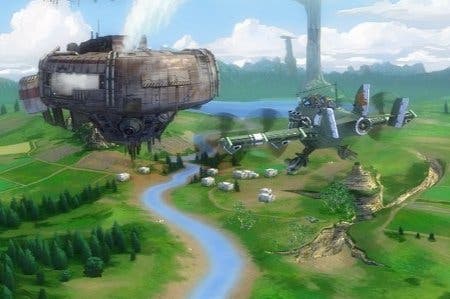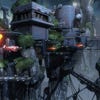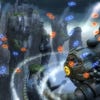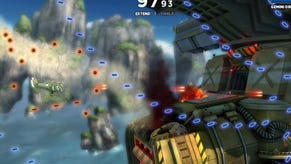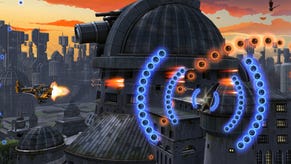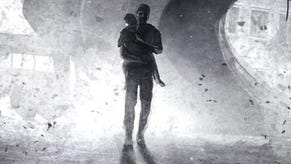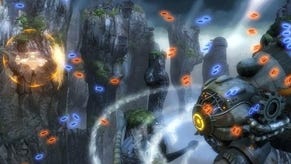Sine Mora Review
Wild blue wonder.
Let's hear it for the niche! As the games industry becomes increasingly obsessed with creating games that are all things to all people, blurring genres to hit as many demographic targets as possible with the least new releases, there's a lot to be said for a game that not only knows precisely who it's targeting, but what it needs to do to make that audience purr. It's in this narrow strip of player real estate that the classic gameplay styles of old have made their home, and it's here that a game like this week's Xbox Live Arcade exclusive Sine Mora thrives.
It's a shoot-'em-up. The shark of the gaming bestiary, the scrolling shmup reached an evolutionary peak very early on and has had little incentive to mutate to adapt to the new gaming climate in the years since. As far as bullet-hell blasters go, what worked in 1987 still works just fine in 2012, thank you very much. That's rather appropriate, as Sine Mora is a game with time on its mind, and questions of a temporal nature inform both the storyline and the gameplay.
The story is as garbled and as dense as you'd expect from any ambitious anime, spinning a largely incoherent yet oddly affecting tale of time travel and regret. It's a diesel punk saga in which plucky resistance fighters return to the past to prevent a madman's expansionist empire from taking control of... well, something.
It's all told in walls of plain text on white backgrounds and bewildering dialogue interludes where lumpy phrases such as "espousing the virtues of patience under Time's shadow is utterly futile" are not uncommon. If you gene-spliced The Terminator and The Lord of the Rings and then used the result to comment on Hiroshima using a cast of foul-mouthed anthropomorphic animals and flowery poetry, you'd be on the right track.
If that synopsis hasn't tipped you off then, yes, Sine Mora is co-developed by Grasshopper Manufacture, Suda 51's esoteric studio - teaming up in this instance with Hungary's Digital Reality.
In gameplay terms, time is a matter of life and death. Each stage is played against a tight time limit, but the clock is extended with every kill you make. Equally, every hit taken reduces the time available. Run out of time and you're dead. In Sine Mora, time and health are sides of the same coin.
Much of the surface action is true to the template set down 30 years ago. You fly left to right (and occasionally right to left) and blast away at the enemies approaching from all sides. Some will leave behind power-ups, ranging from extensions to the time limit to icons that increase your basic attack through one of nine power levels. Take a hit and these icons will spill out and drift away, giving you a few precious seconds to claw back some much-needed firepower.
You also have a limited-use secondary attack and a time-based ability. The secondary attack varies depending on your character and craft, but all are highly destructive and best saved for the many boss encounters.
As for the time abilities, in Story Mode you only get access to one: the chance to slow things down. This enables you to better navigate the swirling patterns of bullets sent your way and gives you much-needed breathing space to take stock, locate the most pressing dangers and plan how you intend to survive to the next section. Story Mode is essentially the tutorial though: a chance to get a punishing first look at the game's increasingly brutal levels as well as unlocking the different characters and craft.
As with any shoot-'em-up worthy of the name, the ultimate goal in Sine Mora doesn't come with completion but with mastery, and validation is found only atop the leaderboard. It's here, in Arcade Mode, that the real meat presents itself.
Stripped of the sometimes distracting narrative interludes, Arcade Mode is where you're free to mix and match the characters and ships to find a combination of powers and attacks that suits your style of play. You also get two additional time abilities, introducing the chance to rewind the action or deflect bullets back to their source. More importantly, Arcade Mode is where the game's fiendish web of scoring systems is pulled into focus.
It's all about the multipliers of course. Keep that fire button pressed down, keep racking up kills, and your score will blossom. Take a hit, or use your secondary attack, and the multiplier is reset. It's a simple yet ruthless bit of design, giving more casual players the leeway to at least see the whole game in a few play-throughs, while taunting the hardcore with the knowledge that any reliance on the game's helping hands will be noted and punished - not with lost lives but deflated scores.
If that seems like a lot of time to spend explaining the mechanics, you have to remember that for a shoot-'em-up, the gameplay is the mechanics and vice versa. The genius of Sine Mora is that it not only understands this, but openly acknowledges that its most dedicated players understand this as well.
Take, for example, the option to replay the boss encounters separately with infinite continues and the weapon loadout of your choice. Or the Score Attack mode that gives you one life to see just how good you really are. Or the fact that the ship selection screen shows you exactly how large the hitbox is for each craft. Longevity here comes not from going pew-pew-pew and reaching the last level, but from attacking the same stage for hours at a time, memorising every scoring opportunity, mastering every wave of enemies, taking advantage of every pixel of safety, adding another few zeroes to the high score each time.
Despite the seeming chaos conjured up by the walls of projectiles you're expected to navigate, the shmup is a genre driven by precision and perfection, and Sine Mora's options indulge this compulsion more ruthlessly than any of its peers. It's the shoot-'em-up equivalent of Guitar Hero's slow tempo practice mode, or the fully featured garage in a driving simulator that lets you fixate on the difference between different types of suspension. It's a game that not only invites obsession but eagerly encourages it. Get better or die trying.
That's not to say that the game is so busy tinkering with the engine that it pays no attention to the bodywork. Sine Mora is perhaps the most visually stunning shooter ever made, its stages unfolding in crisp, bright high definition as scenery tumbles past. And what scenery it is.
From gorgeous blue skies and verdant islands that call to mind Hayao Miyazaki's Nausicaä of the Valley of the Wind, to ominous undersea caverns cast in dark green, to detail-rich vistas of diesel punk cities, Sine Mora is often distractingly beautiful. The 2.5D approach allows your ship to feel part of this world, rather than a flat sprite slapped on top, and the levels are punctuated by dizzying camera moves that swirl and swoop around, reorienting your point of view to reveal new areas or hulking bosses with cinematic grace. These bosses are often beautiful in their own way: vast mechanical fortresses and clockwork insects with names like Chameleon Cannon Leonard and Ancient Predator Libelle, all designed with painterly flair by the revered Evangelion artist Mahiro Maeda.
At 1200 Microsoft Points, this isn't a particularly cheap experience, but for those devotees who will spend months, even years, forcing every last twitch and dodge into their muscle memory, it's money well spent. Clearly not one for casual players, this is a heartfelt love letter to one of gaming's thoroughbred genres and one that fans of the right temperament should experience without delay.
